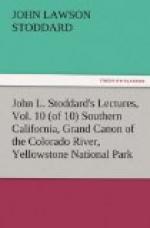If any river in the world should be regarded with superstitious reverence, it is the Colorado, for it represents to us, albeit in a diminished form, the element that has produced the miracle of the Arizona Canon,—water. Far back in the distant Eocene Epoch of our planet’s history, the Colorado was the outlet of an inland sea which drained off toward the Pacific, as the country of northwestern Arizona rose; and the Grand Canon illustrates, on a stupendous scale, the system of erosion which, in a lesser degree, has deeply furrowed the entire region. At first one likes to think of the excavation of this awful chasm as the result of some tremendous cataclysm of Nature; but, in reality, it has all been done by water, assisted, no doubt, by the subtler action of the winds and storms in the disintegration of the monster cliffs, which, as they slowly crumbled into dust, were carried downward by the rains, and, finally, were borne off by the omnivorous river to the sea.
[Illustration: MONSTER CLIFFS, AND A NOTCH IN THE CANON WALL.]
[Illustration: MILES OF INTRA-CANONS.]
But though, at first, these agents do not seem as forceful and extraordinary as a single terrible catastrophe, the slow results thus gained are even more impressive. For what an appalling lapse of time must have been necessary to cut down and remove layers of sandstone, marble, and granite, thousands of feet in thickness; to carve the mighty shrines of Siva and of Vishnu, and to etch out these scores of interlacing canons! To calculate it one must reckon a century for every turn of the hourglass. It is the story of a struggle maintained for ages between the solid and the fluid elements, in which at last the yielding water won a victory over adamant. It is an evidence, too, of Nature’s patient methods; a triumph of the delicate over the strong, the liquid over the solid, the transitory over the enduring. At present, the softer material has been exhausted, and the rapacious river, shrunken in size, must satisfy itself by gnawing only the archaic granite which still curbs its course. Yet if this calculation overpowers us, what shall we say of the reflections awakened by the fact that all the limestone cliffs along the lofty edges of the Canon are composed of fossils,—the skeletons of creatures that once lived here covered by an ocean, and that ten thousand feet of strata, which formerly towered above the present summits of the Canon walls, have been eroded and swept downward to the sea! Hence, were the missing strata (all of which are found in regular sequence in the high plateaus of Utah) restored, this Canon would be sixteen thousand feet in depth, and from its borders one could look down upon a mountain higher than Mont Blanc! To calculate the aeons implied in the repeated elevations and subsidences which made this region what it is would be almost to comprehend eternity. In such a retrospect centuries crumble and disappear into the gulf of Time as pebbles into the Canon of the Colorado.




